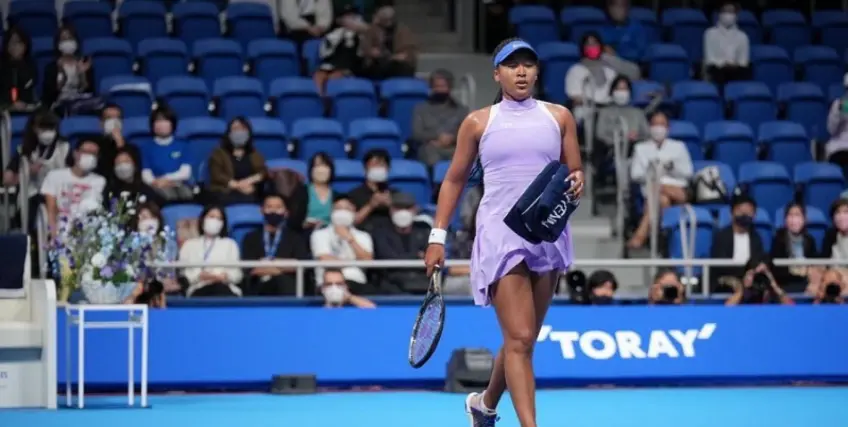
Naomi Osaka has been forced to withdraw from next week’s WTA 500 tournament in Tokyo due to her persistent back injury, the tournament organizers confirmed in a statement. This unfortunate turn of events continues a difficult period for the four-time Grand Slam champion, who has been struggling with her fitness since suffering an injury in Seoul. Osaka’s withdrawal from Tokyo marks the third consecutive tournament she has missed, following her absence from events in Beijing and Wuhan, and now, much to the disappointment of her fans, her highly anticipated return to play in Japan’s premier WTA event has been postponed.
The 27-year-old tennis star, who recently returned to the tour after giving birth to her first child, has faced a series of challenges in her comeback. The injury saga began in Seoul when Osaka retired from her round-of-16 match against Coco Gauff on October 1, citing back pain. At the time, it was unclear how serious the injury was, but subsequent reports indicated that Osaka had sustained the injury during a pre-match warm-up. Despite her initial hopes of a quick recovery, the injury has proven more troublesome than expected, forcing her to pull out of not just the Tokyo tournament but also other key events on the Asian swing of the WTA calendar.
Missing the Toray Pan Pacific Open, Tokyo’s biggest WTA tournament, is a significant blow for Osaka on multiple levels. The tournament holds special importance to the Japanese tennis star, as it is one of her home country’s marquee events, and she was looking forward to making her first appearance there as a mother. The former world No. 1 had been targeting the Tokyo event as a crucial step in her ongoing comeback and had hoped to reconnect with her fans in Japan after her time away from the tour.
For the Tokyo tournament organizers and Osaka’s supporters, her withdrawal represents a major disappointment. Osaka’s popularity in Japan is immense, and her presence at the event would have been a significant draw for local tennis fans. As one of Japan’s most celebrated athletes, her absence leaves a noticeable void in the tournament lineup, and it underscores the difficult realities of her current physical condition. The Tokyo tournament is known for attracting top-tier talent, and Osaka’s participation would have been a highlight of the event. Unfortunately, the injury means both the player and her fans will have to wait longer for her long-awaited homecoming.
The news of her Tokyo withdrawal didn’t come as a complete surprise, however. Just a few days ago, Osaka addressed her injury during a Q&A session on Instagram, where she hinted at the possibility of missing the event. When asked by a fan about her chances of competing in Tokyo, Osaka replied, “It was worse than what I thought (I just have a high pain tolerance lol) and I’m trying my best to potentially play Tokyo, but I’m still waiting to see what the doctor says.” Her response indicated that while she was hopeful, the injury was more severe than initially anticipated, and her body might not be ready in time.
Osaka’s cautious approach to her recovery is understandable given the nature of back injuries, which can be particularly tricky to manage for tennis players. Back pain can hinder movement, affect power, and disrupt a player’s rhythm, making it difficult to compete at the highest level. For Osaka, who relies on her powerful serve and aggressive baseline game, being less than 100% physically would put her at a significant disadvantage. It seems clear that both Osaka and her team are taking a longer-term view of her recovery, prioritizing her overall health and well-being over a quick return to competition.
Looking ahead, the question now turns to when Osaka will be able to return to the court. According to recent reports, the former world No. 1 has signed up to play the WTA 250 tournament in Hong Kong, which is set to begin the week following the Tokyo event. If her recovery progresses well, Osaka could make her second career appearance in Hong Kong. She previously competed there seven years ago, reaching the quarterfinals in her debut. Given the lower level of competition compared to the WTA 500, the Hong Kong event could provide Osaka with a more manageable re-entry into competitive play, allowing her to gauge her fitness and form before taking on more grueling tournaments.
In addition to Osaka, the Hong Kong tournament is set to feature several high-profile players, including Simona Halep and Emma Raducanu, making it an exciting event on the calendar. Osaka’s fans will be hoping that the extra week of rest and rehabilitation will enable her to make a full recovery in time for the tournament, which begins on October 28th. If Osaka is able to participate, it will mark another important milestone in her post-motherhood comeback, as she continues to balance the demands of life as a professional athlete with her newfound role as a mother.
While the situation is far from ideal, Osaka’s decision to withdraw from Tokyo is a reminder of the importance of patience and careful management in her recovery process. Injuries are an unfortunate part of any athlete’s career, but for Osaka, who has already shown incredible resilience in overcoming various challenges throughout her career, this setback is likely just another chapter in her ongoing journey. Her fans will undoubtedly be eagerly awaiting her return, whether it happens in Hong Kong or later in the season.
For now, all eyes will be on her recovery, and there is hope that Naomi Osaka will soon be back competing at the level that made her a four-time Grand Slam champion. Until then, the tennis world continues to support her as she navigates this challenging phase of her career.
Leave a Reply